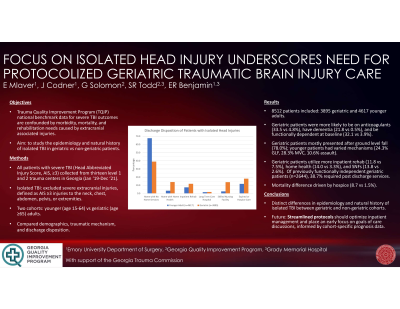Quality Improvement
Category: Quickshot Oral Session 15
Quickshot Oral : Quickshot Oral Session 15
FOCUS ON ISOLATED HEAD INJURY UNDERSCORES NEED FOR PROTOCOLIZED GERIATRIC TRAUMATIC BRAIN INJURY CARE
Monday, February 13, 2023
7:00am - 8:00am East Coast USA Time


Eli Mlaver, MD (he/him/his)
Resident
Emory University, United States
Eli Mlaver, MD (he/him/his)
Resident
Emory University, United States
Presenter(s)
Principal Contact(s)
Objectives: Traumatic brain injury (TBI) remains a leading cause of morbidity and mortality in trauma. Trauma Quality Improvement Program (TQIP) national benchmark data captures outcomes after severe TBI, however these data are confounded by morbidity, mortality, and rehabilitation needs caused by extracranial associated injuries. Using data on isolated head injuries from the Georgia Quality Improvement Collaborative, the purpose of this study was to identify potential areas for patient-centered protocols that could optimize the care of patients with TBI.
Methods: All patients with severe TBI (Head Abbreviated Injury Score, AIS, ≥3) were collected from thirteen level 1 and 2 trauma centers in Georgia (Jan 2019-Dec 2021). Isolated TBI was identified by excluding patients with severe extracranial injuries, defined as AIS>2 injuries to the neck, chest, abdomen, pelvis, or extremities. The study population was divided into two cohorts, younger (age 15-64) and geriatric (age ≥65) adults. Demographics and disposition were compared.
Results: A total of 8512 patients were included, 3895 geriatric (mean age 78.2 years, SD 8.1) and 4617 younger adults (mean age 40.4 years, SD 15.0). Geriatric patients were more likely to be on anticoagulants (33.5 vs 4.8%), have dementia (21.8 vs 0.5%), and be functionally dependent at baseline (32.1 vs 3.9%). Geriatric patients most commonly presented after ground level fall (78.0%), whereas younger patients had more varied mechanisms of injury (24.3% GLF, 28.3% MVC, 10.6% assault). Mean Head AIS was 3.77 and 3.69, respectively. ICU admission rates were 61.0 and 60.0%. Geriatric patients were less likely to be discharged home without home services (39.0 vs 67.7%) and were more likely to utilize inpatient rehab (11.8 vs 7.5%), home health (14.0% vs 3.3%), and skilled nursing facilities (13.8% vs 2.6%). Of previously functionally independent geriatric patients (n=2644), 38.7% required post discharge services. Mortality was higher in the geriatric population (18.1 vs 11.7%), driven by higher rate of hospice transition (8.7 vs 1.5%).
Conclusion: Using a single state population of isolated TBI patients, these data support the need for population-specific protocols. Isolated severe TBI presented in two distinct cohorts, with ground level falls as the overwhelmingly most common mechanism of injury in the geriatric cohort. Post-discharge, geriatric patients are more likely to require services and/or facility placement, regardless of pre-injury functional status. These data highlight the importance of streamlined protocols that optimize inpatient management and place an early focus on goals of care discussions, informed by cohort-specific prognosis data.
Methods: All patients with severe TBI (Head Abbreviated Injury Score, AIS, ≥3) were collected from thirteen level 1 and 2 trauma centers in Georgia (Jan 2019-Dec 2021). Isolated TBI was identified by excluding patients with severe extracranial injuries, defined as AIS>2 injuries to the neck, chest, abdomen, pelvis, or extremities. The study population was divided into two cohorts, younger (age 15-64) and geriatric (age ≥65) adults. Demographics and disposition were compared.
Results: A total of 8512 patients were included, 3895 geriatric (mean age 78.2 years, SD 8.1) and 4617 younger adults (mean age 40.4 years, SD 15.0). Geriatric patients were more likely to be on anticoagulants (33.5 vs 4.8%), have dementia (21.8 vs 0.5%), and be functionally dependent at baseline (32.1 vs 3.9%). Geriatric patients most commonly presented after ground level fall (78.0%), whereas younger patients had more varied mechanisms of injury (24.3% GLF, 28.3% MVC, 10.6% assault). Mean Head AIS was 3.77 and 3.69, respectively. ICU admission rates were 61.0 and 60.0%. Geriatric patients were less likely to be discharged home without home services (39.0 vs 67.7%) and were more likely to utilize inpatient rehab (11.8 vs 7.5%), home health (14.0% vs 3.3%), and skilled nursing facilities (13.8% vs 2.6%). Of previously functionally independent geriatric patients (n=2644), 38.7% required post discharge services. Mortality was higher in the geriatric population (18.1 vs 11.7%), driven by higher rate of hospice transition (8.7 vs 1.5%).
Conclusion: Using a single state population of isolated TBI patients, these data support the need for population-specific protocols. Isolated severe TBI presented in two distinct cohorts, with ground level falls as the overwhelmingly most common mechanism of injury in the geriatric cohort. Post-discharge, geriatric patients are more likely to require services and/or facility placement, regardless of pre-injury functional status. These data highlight the importance of streamlined protocols that optimize inpatient management and place an early focus on goals of care discussions, informed by cohort-specific prognosis data.

